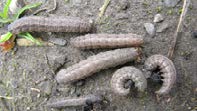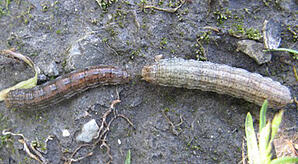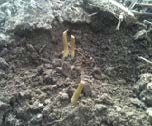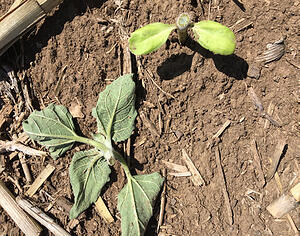
Jun 6, 2019, 10:00 AM
Cutworms in Sunflowers
When everything looks great from a distance, don’t forget to get out of the pickup and check your sunflower fields for cutworms this time of year. Sunflowers can have irreversible damage in the seedling stage from several species of cutworms. Damage is caused by cutting off the seedling, sometimes below the cotyledon or before they even emerge out of the ground. As the plant matures, damage moves to the leaves and the plant is typically able to recover (V4-V6 stage).
 Dingy Cutworms Dingy CutwormsPhoto Credit: SDSU iGrow taken by J. Gavloski, MAFRI |
 Redbacked Cutworm (left Redbacked Cutworm (leftDarksided Cutworm (right) Photo Credit: Agriculture Canada |
 Sunflowers damaged by cutworms Sunflowers damaged by cutwormsat the soil surface. |
 Cutworm damage at V4 Stage Cutworm damage at V4 Stage |
Here are some key factors to consider for cutworms in sunflowers:
- Damage can first be noticed by bare patches in a field or several missing plants in a row.
- Generally, cutworms can first be found on warmer south facing slopes, areas that border grass/pasture or a spot in the field that has weed issues the year before.
- Scouting towards the evening can be helpful, otherwise look underneath the soil surface or stubble during the day.
- When a row is missing plants, start by looking near the next undamaged plant for the cutworm.
- Take note of the size of the cutworm. Small larvae pose the greatest potential for damage as they continue to feed and grow. Larger cutworms, 1.25” to 1.5” (depending on the species) are close to pupating and feed less.
Action Plan
- Economic threshold is when you have a 25-30% stand reduction or when there is one small larva (1 inch or smaller) per square foot.
- Several insecticides work well if cutworms are feeding on the surface.
- Spraying towards nightfall is best.
Summary
To minimize stand loss in the spring, scout for cutworms through at least the V4 stage. Once a plant is cut below the cotyledon it will not come back.

Resources
https://www.ag.ndsu.edu/extensionentomology/recent-publications-main/publications/A-1331-sunflower-production-field-guide
Compendium of Sunflower Diseases, 2016
Author: Nuseed Product Development Manager Alison Pokrzywinski

